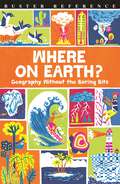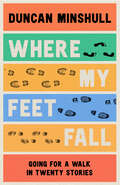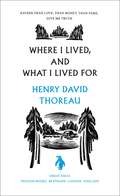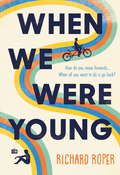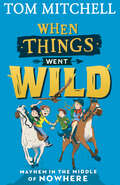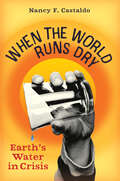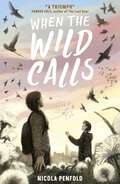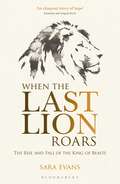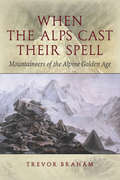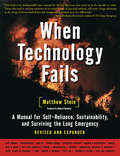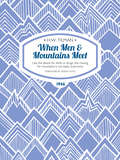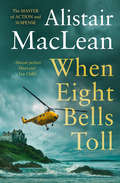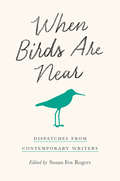- Table View
- List View
Where On Earth?: Geography Without the Boring Bits
by James DoyleWhere on Earth? is jam-packed with all of geography's greatest hits, with all the boring bits taken out. From how to make a raindrops to cool ways to remember the world's wonderful waterfalls, longest rivers and most desolate deserts - plus all the countries and continents in which these fantastic features are found. The perfect learning companion to help all school children get to grips with discovering the world around them.
Where No Gods Came (Sweetwater Fiction: Originals)
by Sheila O'ConnorWinner 2003 Michigan Literary Fiction Award for original novel "Written with precision and perception, this is a highly recommended work from a writer to watch." ---Library Journal "O'Connor . . . remains a consummate artist, true to her vision of a work that is bleak, truthful, and lacking any overt sentimental overtures. Her eye, a poet's eye, misses nothing." ---three candles ". . . a touching odyssey of a girl poised between the emotional abyss and the reader's heart." ---Minneapolis Star-Tribune "A sensitive, often disquieting book that rings true throughout. . . . It's the skill of an accomplished writer that we see Faina's extraordinary spirit, while simultaneously experiencing her pain and despair. The end result is an uplifting, even inspiring book without any of the sugarcoating often found in stories like this." ---California Literary Review Where No Gods Came is author Sheila O'Connor's compelling story of Faina McCoy, a young girl caught in a perilous scheme of elaborate lies created for her own harrowing system of survival. Enmeshed in a tangled family web, Faina is abruptly uprooted against her will from her father and finds herself half a continent away on the doorstep of a mother who abandoned her years before-but who can't live without Faina now. Alone, persecuted, and exploited, Faina must fend for herself as she searches for love and answers, navigating the streets of a strange city and forging bonds of feeling with liars and outlaws.
Where My Feet Fall: Going For A Walk In Twenty Stories
by Duncan MinshullWhere can a walk take you?
Where I Lived, and What I Lived For
by Henry ThoreauThroughout history, some books have changed the world. They have transformed the way we see ourselves - and each other. They have inspired debate, dissent, war and revolution. They have enlightened, outraged, provoked and comforted. They have enriched lives - and destroyed them. Now Penguin brings you the works of the great thinkers, pioneers, radicals and visionaries whose ideas shook civilization and helped make us who we are.Thoreau's account of his solitary and self-sufficient home in the New England woods remains an inspiration to the environmental movement - a call to his fellow men to abandon their striving, materialistic existences of 'quiet desperation' for a simple life within their means, finding spiritual truth through awareness of the sheer beauty of their surroundings.
Where Have All the Birds Gone?: Essays on the Biology and Conservation of Birds That Migrate to the American Tropics
by John Terborgh"Things are going wrong with our environment," writes John Terborgh, "even the parts of it that are nominally protected. If we wait until all the answers are in, we may find ourselves in a much worse predicament than if we had taken notice of the problem earlier. By waiting, one risks being too late; on the other hand, there can be no such thing as being too early." Terborgh's warnings are essential reading for all who care about migratory birds and our natural environment. Why are tropical migrant species disappearing from our forests? Can we save the birds that are left? Terborgh takes a more comprehensive view of migratory birds than is usual--by asking how they spend their lives during the half-year they reside in the tropics. By scrutinizing ill-planned urban and suburban development in the United States and the tropical deforestation of Central and South America, he summarizes our knowledge of the subtle combination of circumstances that is devastating our bird populations. This work is pervaded by Terborgh's love for the thrushes, warblers, vireos, cuckoos, flycatchers, and tanagers that inhabited his family's woodland acreage while he was growing upbirds that no longer live there, in spite of the preservation of those same woods as part of a county park. The book is a tour of topics as varied as ecological monitoring, the plight of the Chesapeake wetlands, the survival struggle of Central American subsistence farmers, and the management of commercial forests.
Where Have All the Birds Gone?: Essays on the Biology and Conservation of Birds That Migrate to the American Tropics
by John Terborgh"Things are going wrong with our environment," writes John Terborgh, "even the parts of it that are nominally protected. If we wait until all the answers are in, we may find ourselves in a much worse predicament than if we had taken notice of the problem earlier. By waiting, one risks being too late; on the other hand, there can be no such thing as being too early." Terborgh's warnings are essential reading for all who care about migratory birds and our natural environment. Why are tropical migrant species disappearing from our forests? Can we save the birds that are left? Terborgh takes a more comprehensive view of migratory birds than is usual--by asking how they spend their lives during the half-year they reside in the tropics. By scrutinizing ill-planned urban and suburban development in the United States and the tropical deforestation of Central and South America, he summarizes our knowledge of the subtle combination of circumstances that is devastating our bird populations. This work is pervaded by Terborgh's love for the thrushes, warblers, vireos, cuckoos, flycatchers, and tanagers that inhabited his family's woodland acreage while he was growing upbirds that no longer live there, in spite of the preservation of those same woods as part of a county park. The book is a tour of topics as varied as ecological monitoring, the plight of the Chesapeake wetlands, the survival struggle of Central American subsistence farmers, and the management of commercial forests.
When We Were Young
by Richard Roper'Such a warm, uplifting read. It's a celebration of the bond we have with our oldest friends, and it's so funny' Beth O'Leary'A brilliant, funny, insightful exploration of friendship, which properly made me laugh and cry' Laura Marshall---------Theo has been living in his parents' shed, nursing a broken heart and a wounded ego, convinced life can't get any worse. Then he gets evicted on his 30th birthday. Theo thinks he's done with the real world - until it shows up on his doorstep...Joel is a successful TV scriptwriter, still in love with his teenage sweetheart. A proper grown-up - and yet he's falling apart at the seams. He's headed home to reconnect with best friend Theo - except they haven't spoken since the summer they turned 16.One of them is keeping a secret, and the other is living a lie. But can the promise they once made to walk all 184 miles of the Thames Path help them find their way back to the truth - and to their friendship?A tender and funny story about wanting to go back - when you know it's time to move on.---------'An uplifting and redemptive journey' Steven Rowley'A beautifully bittersweet tale about the enduring power of friendship, reminding us how sometimes the best way to face life's biggest challenges is to take them one step at a time with your best friend by your side' Oliver Sands'An absorbing and heartfelt tale of past mistakes and friendship lost but never forgotten. A joyful summer read' Owen Nicholls---------Your favourite authors loved reading Richard Roper's uplifting first novel, Something to Live For:'A magnificent read. Tender, funny, compelling' Lucy Foley'Funny, moving and thought-provoking - I loved this' Clare Mackintosh'I adored this! It warmed my heart, broke it a little, then put it back together' Beth O'Leary'Funny, fresh and achingly tender. Richard's writing hooked me in from the very first page' Cathy Bramley'A life-affirming novel that simultaneously tweaks your funny-bone and tugs at your heartstrings. Brilliant!' Matt Dunn'It pulls you in, makes you laugh and breaks your heart' Gill Hornby
When Things Went Wild
by Tom MitchellA hilarious whodunit adventure for readers aged 9+ from the author of ESCAPE FROM CAMP BORING. Full of mishaps, mayhem and Tom Mitchell’s trademark wit, WHEN THINGS WENT WILD is also a timely call to protect our environment and its wildlife.
When the World Runs Dry: Earth's Water in Crisis
by Nancy F. CastaldoAward-winning science writer Nancy F. Castaldo gives a riveting narrative nonfiction account of the worldwide water crisis, explaining what&’s happening to the world&’s water supply, from industrial pollution to harmful algal blooms, and what kids can do about it.
When the Wild Calls (Where the World Turns Wild #2)
by Nicola PenfoldHaving escaped their city, Juniper Greene and her brother Bear have settled in Ennerdale with their dad and his family. Every day the wild introduces them to a new wonder, but Juniper can't stop worrying about her grandmother and best friend left behind. When she hears news that disease has entered the city, she's determined to bring her loved ones to safety. Trapped in a city riddled with disease and run by a ruthless leader, Etienne longs for the wild. With the guards becoming more aggressive to counteract the growing rebellion, Etienne's prepared to fight for his freedom. But will he be able to protect himself and keep those around him safe until Juniper returns from the wild?
When the Sahara Was Green: How Our Greatest Desert Came to Be
by Martin WilliamsThe little-known history of how the Sahara was transformed from a green and fertile land into the largest hot desert in the worldThe Sahara is the largest hot desert in the world, equal in size to China or the United States. Yet, this arid expanse was once a verdant, pleasant land, fed by rivers and lakes. The Sahara sustained abundant plant and animal life, such as Nile perch, turtles, crocodiles, and hippos, and attracted prehistoric hunters and herders. What transformed this land of lakes into a sea of sands? When the Sahara Was Green describes the remarkable history of Earth’s greatest desert—including why its climate changed, the impact this had on human populations, and how scientists uncovered the evidence for these extraordinary events.From the Sahara’s origins as savanna woodland and grassland to its current arid incarnation, Martin Williams takes us on a vivid journey through time. He describes how the desert’s ancient rocks were first fashioned, how dinosaurs roamed freely across the land, and how it was later covered in tall trees. Along the way, Williams addresses many questions: Why was the Sahara previously much wetter, and will it be so again? Did humans contribute to its desertification? What was the impact of extreme climatic episodes—such as prolonged droughts—upon the Sahara’s geology, ecology, and inhabitants? Williams also shows how plants, animals, and humans have adapted to the Sahara and what lessons we might learn for living in harmony with the harshest, driest conditions in an ever-changing global environment.A valuable look at how an iconic region has changed over millions of years, When the Sahara Was Green reveals the desert’s surprising past to reflect on its present, as well as its possible future.
When the Planet Rages: Natural Disasters, Global Warming and the Future of the Earth
by Charles Officer Jake PageIn New England, 1816 was called the Year Without a Summer. Crops failed throughout America and, in Western Europe, it was even worse, with food riots and armed groups raiding bakeries and grain markets. All this turmoil followed a catastrophic volcanic eruption--a year earlier on the other side of the world--the eruption of Tambora, a blast heard almost a thousand miles away. In When the Planet Rages, Charles Officer and Jake Page describe some of the great events of environmental history, from calamities such as the Lisbon earthquake of 1755 (the greatest in recorded history) and the ice ages, to recent man-made disasters such as Chernobyl, acid rain, and the depletion of the ozone layer. Officer and Page provide fascinating discussions of meteorites and comets; of the demise of mammoths, mastodons, and dinosaurs; and of great floods that have swept the earth. But they also show that human activity can make trouble for nature, discussing the depletion of natural resources (we burn coal and oil at millions of times their natural rate of production), air pollution in Los Angeles and London (where the Killer Smog of 1952 caused the death of some four thousand people), and the pollution of major waterways, like the Chesapeake Bay and Lake Erie. For the paperback edition, the authors have included a new preface, have added material on the recent Sichuan, China earthquake, the Indian Ocean Tsunami, and Hurricane Katrina, and discuss such topics as of the (un)predictability of symptoms of global warming. Ranging from the monumental eruption at Krakatoa to industrial disasters such as the mercury poisoning in Japan's Minamata Bay, When the Planet Rages will engage anyone concerned with the environment and the natural world.
When the Last Lion Roars: The Rise and Fall of the King of the Beasts
by Sara EvansThe illegal killing of Cecil – a famous and magnificent black-maned Zimbabwean lion – by an American big-game hunter in 2015 sparked international outrage. More significantly, it drew the world's attention to the devastating plight of Africa's lions. A century ago, there were more than 200,000 wild lions living in Africa. Today, with that population reduced by more than 90 per cent, many experts believe that without effective conservation plans, Africa's remaining wild lions could be completely wiped out by the mid-half of this century. When the Last Lion Roars explores the historic rise and fall of the lion as a global species, and examines the reasons behind its catastrophic decline. Interwoven with vivid personal encounters of Africa's last lions, Sara Evans questions what is being done to reverse (or at least stem) this population collapse, and she considers the importance of human responsibility in this decline and, more crucially, in their conservation. From the Lion Guardians in Kenya to the Living Walls of Tanzania, and the Hwange Lion Research Project in Zimbabwe, Sara meets both lions and their champions, people who are fighting to bring this iconic species back from the brink of extinction.
When the Last Lion Roars: The Rise and Fall of the King of the Beasts
by Sara EvansThe illegal killing of Cecil – a famous and magnificent black-maned Zimbabwean lion – by an American big-game hunter in 2015 sparked international outrage. More significantly, it drew the world's attention to the devastating plight of Africa's lions. A century ago, there were more than 200,000 wild lions living in Africa. Today, with that population reduced by more than 90 per cent, many experts believe that without effective conservation plans, Africa's remaining wild lions could be completely wiped out by the mid-half of this century. When the Last Lion Roars explores the historic rise and fall of the lion as a global species, and examines the reasons behind its catastrophic decline. Interwoven with vivid personal encounters of Africa's last lions, Sara Evans questions what is being done to reverse (or at least stem) this population collapse, and she considers the importance of human responsibility in this decline and, more crucially, in their conservation. From the Lion Guardians in Kenya to the Living Walls of Tanzania, and the Hwange Lion Research Project in Zimbabwe, Sara meets both lions and their champions, people who are fighting to bring this iconic species back from the brink of extinction.
When the Alps Cast Their Spell: Mountaineers of the Alpine Golden Age
by Trevor BrahamThe sport of mountaineering was pioneered 150 years ago by a diverse cross-section of Victorians, following in the footsteps of earlier local explorers who ventured into the upper regions of ice and snow in search of game and minerals. By the early years of the 19th century, a growing interest in the study of geological and glaciological phenomena attracted scientific interest in the origins of the Alps. It was only in the latter half of that century when, by the 1850s, interest in the largly unexplored Alpine peaks began to capture the public imagination, and a sharp increase developed in the numbers of those who tried to scale them. So intense was the level of exploration and achievement that the next decade was labelled the Alpine Golden Age. By the turn of the century the new sport had not only expanded vastly, but had begun to acquire a degree of respectability. The development of new skills and techniques resulted in greater accomplishments, whilst retaining the spirit and traditions of the pioneers. In this book the mountaineer and writer Trevor Braham illustrates aspects of the character and achievements of some of the early Victorian climbers, and their response to the unique attractions of mountaineering. These include Leslie Stephen (the father of Virginia Woolf), Alfred Wills, John Tyndall, Adolphus Warburton Moore, Edward Whymper (the first to conquer the Matterhorn), Albert Frederick Mummery and many more. Trevor Braham's comprehensive history on this period of Alpine mountaineering is essential to any mountaineer's bookshelf.
When Technology Fails: A Manual for Self-Reliance, Sustainability, and Surviving the Long Emergency, 2nd Edition
by Matthew SteinThere’s never been a better time to “be prepared.” Matthew Stein’s comprehensive primer on sustainable living skills—from food and water to shelter and energy to first-aid and crisis-management skills—prepares you to embark on the path toward sustainability. But unlike any other book, Stein not only shows you how to live “green” in seemingly stable times, but to live in the face of potential disasters, lasting days or years, coming in the form of social upheaval, economic meltdown, or environmental catastrophe. When Technology Fails covers the gamut. You’ll learn how to start a fire and keep warm if you’ve been left temporarily homeless, as well as the basics of installing a renewable energy system for your home or business. You’ll learn how to find and sterilize water in the face of utility failure, as well as practical information for dealing with water-quality issues even when the public tap water is still flowing. You’ll learn alternative techniques for healing equally suited to an era of profit-driven malpractice as to situations of social calamity. Each chapter (a survey of the risks to the status quo; supplies and preparation for short- and long-term emergencies; emergency measures for survival; water; food; shelter; clothing; first aid, low-tech medicine, and healing; energy, heat, and power; metalworking; utensils and storage; low-tech chemistry; and engineering, machines, and materials) offers the same approach, describing skills for self-reliance in good times and bad. Fully revised and expanded—the first edition was written pre-9/11 and pre-Katrina, when few Americans took the risk of social disruption seriously—When Technology Fails ends on a positive, proactive note with a new chapter on "Making the Shift to Sustainability," which offers practical suggestions for changing our world on personal, community and global levels.
When Rights Embrace Responsibilities: Biocultural Rights and the Conservation of Environment
by Giulia SajevaThe conservation of environment and the protection of human rights are two of the most compelling needs of our time. Unfortunately, they are not always easy to combine and too often result in mutual harm. This book analyses the idea of biocultural rights as a proposal for harmonizing the needs of environmental and human rights. These rights, considered as a basket of group rights, are those deemed necessary to protect the stewardship role that certain indigenous peoples and local communities have played towards the environment. With a view to understanding the value and merits, as well as the threats that biocultural rights entail, the book critically assesses their foundations, content, and implications, and develops new perspectives and ideas concerning their potential applicability for promoting the socio-economic interests of indigenous people and local communities. It further explores the controversial relationship of interdependence and conflict between conservation of environment and protection of human rights.
When Men & Mountains Meet: Like the desire for drink or drugs, the craving for mountains is not easily overcome (H.W. Tilman: The Collected Edition)
by H.W. Tilman‘We had climbed a mountain and crossed a pass; been wet, cold, hungry, frightened, and withal happy. One more Himalayan season was over. It was time to begin thinking of the next. “Strenuousness is the immortal path, sloth is the way of death.”’First published in 1946, the scope of H.W. ‘Bill’ Tilman’s When Men and Mountains Meet is broad, covering his disastrous expedition to the Assam Himalaya, a small exploratory trip into Sikkim, and then his wartime heroics.In the thirties, Assam was largely unknown and unexplored. It proved a challenging environment for Tilman’s party, the jungle leaving the men mosquito-bitten and suffering with tropical diseases, and thwarting their mountaineering success. Sikkim proved altogether more successful. Tilman, who is once again happy and healthy, enjoys some exploratory ice climbing and discovers Abominable Snowman tracks, particularly remarkable as the creature appeared to be wearing boots—‘there is no reason why he should not have picked up a discarded pair at the German Base Camp and put them to their obvious use'.And then, in 1939, war breaks out. With good humour and characteristic understatement we hear about Tilman’s remarkable Second World War. After digging gun pits on the Belgian border and in Iraq, he was dropped by parachute behind enemy lines to fight alongside Albanian and Italian partisans. Tilman was awarded the Distinguished Service Order for his efforts—and the keys to the city of Belluno, which he helped save from occupation and destruction.Tilman’s comments on the German approach to Himalayan climbing could equally be applied to his guerrilla warfare ethos. ‘They spent a lot of time and money and lost a lot of climbers and porters, through bad luck and more often through bad judgement.’ While elsewhere the war machine rumbled on, Tilman’s war was fast, exciting, lightweight and foolhardy—and makes for gripping reading.
When God Isn't Green: A World-wide Journey To Places Where Religious Practice And Environmentalism Collide
by Jay WexlerIn this lively, round-the-world trip, law professor and humorist Jay Wexler explores the intersection of religion and the environment. Did you know that In Hong Kong and Singapore, Taoists burn paper money to appease "hungry ghosts," filling the air with smoke and dangerous toxins? In Mumbai, Hindus carry twenty-foot-tall plaster of Paris idols of the elephant god Ganesh into the sea and leave them on the ocean floor to symbolize the impermanence of life, further polluting the scarce water resources of western India? In Taiwan, Buddhists practicing "mercy release" capture millions of small animals and release them into inappropriate habitats, killing many of the animals and destroying ecosystems? In Central America, palm frond sales to US customers for Palm Sunday celebrations have helped decimate the rain forests of Guatemala and southern Mexico? In New York, Miami, and other large US cities, Santeria followers sprinkle mercury in their apartments to fend off witches, poisoning those homes for years to come? In Israel, on Lag B'omer, a holiday commemorating a famous rabbi, Jews make so many bonfires that the smoke can be seen from space, and trips to the emergency room for asthma and other pulmonary conditions spike? Law professor and humorist Jay Wexler travels the globe in order to understand the complexity of these problems and learn how society can best address them. He feasts on whale blubber in northern Alaska, bumps along in the back of a battered jeep in Guatemala, clambers down the crowded beaches of Mumbai, and learns how to pluck a dead eagle in Colorado, all to answer the question "Can religious practice and environmental protection coexist?"
When Fracking Comes to Town: Governance, Planning, and Economic Impacts of the US Shale Boom
When Fracking Comes to Town traces the response of local communities to the shale gas revolution. Rather than cast communities as powerless to respond to oil and gas companies and their landmen, it shows that communities have adapted their local rules and regulations to meet the novel challenges accompanying unconventional gas extraction through fracking. The multidisciplinary perspectives of this volume's essays tie together insights from planners, legal scholars, political scientists, and economists. What emerges is a more nuanced perspective of shale gas development and its impacts on municipalities and residents. Unlike many political debates that cast fracking in black-and-white terms, this book's contributors embrace the complexity of local responses to fracking. States adapted legal institutions to meet the new challenges posed by this energy extraction process while under-resourced municipal officials and local planning offices found creative ways to alleviate pressure on local infrastructure and reduce harmful effects of fracking on the environment. The essays in When Fracking Comes to Town tell a story of community resilience with the rise and decline of shale gas production. Contributors: Ennio Piano, Ann M. Eisenberg, Pamela A. Mischen, Joseph T. Palka, Jr., Adelyn Hall, Carla Chifos, Teresa Córdova, Rebecca Matsco, Anna C. Osland, Carolyn G. Loh, Gavin Roberts, Sandeep Kumar Rangaraju, Frederick Tannery, Larry McCarthy, Erik R. Pages, Mark C. White, Martin Romitti, Nicholas G. McClure, Ion Simonides, Jeremy G. Weber, Max Harleman, Heidi Gorovitz Robertson
When Eight Bells Toll
by Alistair MacLeanFrom the acclaimed master of action and suspense. The all time classic
When Birds Are Near: Dispatches from Contemporary Writers
In this dazzling literary collection, writers explore and celebrate their lives with and love for birds—detailing experiences from Alaska to Bermuda, South Dakota to Panama. In When Birds Are Near, fresh new voices as well as seasoned authors offer tales of adventure, perseverance, and fun, whether taking us on a journey down Highway 1 to see a rare California Condor, fighting the destruction of our grasslands, or simply watching the feeder from a kitchen window.But these essays are more than just field notes. The authors reflect on love, loss, and family, engaging a broad array of emotions, from wonder to amusement. As Rob Nixon writes, "Sometimes the best bird experiences are defined less by a rare sighting than by a quality of presence, some sense of overall occasion that sets in motion memories of a particular landscape, a particular light, a particular choral effect, a particular hiking partner." Or, as the poet Elizabeth Bradfield remarks, "We resonate with certain animals, I believe, because they are a physical embodiment of an answer we are seeking. A sense of ourselves in the world that is nearly inexpressible." When Birds Are Near gives us the chance to walk alongside these avid appreciators of birds and reflect on our own interactions with our winged companions.Contributors: Christina Baal, Thomas Bancroft, K. Bannerman, R. A. Behrstock, Richard Bohannon, Elizabeth Bradfield, Christine Byl, Susan Cerulean, Sara Crosby, Jenn Dean, Rachel Dickinson, Katie Fallon, Jonathan Franzen, Andrew Furman, Tim Gallagher, David Gessner, Renata Golden, Ursula Murray Husted, Eli J. Knapp, Donald Kroodsma, J. Drew Lanham, John R. Nelson, Rob Nixon, Jonathan Rosen, Alison Townsend, Alison Világ
Wheat Production in Changing Environments: Responses, Adaptation and Tolerance
by Mirza Hasanuzzaman Kamrun Nahar Md. Amzad HossainThis book presents recent advances in global wheat crop research, including the effects of abiotic stresses like high and low temperatures, drought, hypoxia, salinity, heavy metals, nutrient deficiency, and toxicity on wheat production. It also highlights various approaches to alleviate the damaging effects of abiotic stress on wheat as well as advanced approaches to develop abiotic-stress-tolerant wheat crops. Wheat is probably one of the world’s most important cereals; it is a staple food in more than 40 countries, and because of its adaptability is cultivated in almost every region. Global wheat production has more than doubled in the last 50 years due to higher yields. However, despite their high yield potential, modern wheat cultivars are often subject to crop loss due to the abiotic stresses. As such, plant breeders have long aimed to improve tolerance in order to maintain yield. Written by 85 experts, and offering the latest insights into wheat responses and tolerance to various abiotic stresses, it is a valuable tool for agronomists, plant breeders, plant physiologists and students in the field of plant science and agriculture. It is the first book to comprehensively cover past and current abiotic stress problems and tolerance mechanisms.
What's Wrong with Climate Politics and How to Fix It (What's Wrong? #7)
by Paul G. HarrisGovernments have failed to stem global emissions of carbon dioxide and other greenhouse gases causing climate change. Indeed, climate-changing pollution is increasing globally, and will do so for decades to come without far more aggressive action. What explains this failure to effectively tackle one of the world's most serious problems? And what can we do about it? To answer these questions, Paul G. Harris looks at climate politics as a doctor might look at a very sick patient. He performs urgent diagnoses and prescribes vital treatments to revive our ailing planet before it's too late. The book begins by diagnosing what’s most wrong with climate politics, including the anachronistic international system, which encourages nations to fight for their narrowly perceived interests and makes major cuts in greenhouse pollution extraordinarily difficult; the deadlock between the United States and China, which together produce over one-third of global greenhouse gas pollution but do little more than demand that the other act first; and affluent lifestyles and overconsumption, which are spreading rapidly from industrialized nations to the developing world. The book then prescribes several "remedies" for the failed politics of climate change, including a new kind of climate diplomacy with people at its center, national policies that put the common but differentiated responsibilities of individuals alongside those of nations, and a campaign for simultaneously enhancing human wellbeing and environmental sustainability. While these treatments are aspirational, they are not intended to be utopian. As Harris shows, they are genuine, workable solutions to what ails the politics of climate change today.
What's Wrong with Climate Politics and How to Fix It (What's Wrong?)
by Paul G. HarrisGovernments have failed to stem global emissions of carbon dioxide and other greenhouse gases causing climate change. Indeed, climate-changing pollution is increasing globally, and will do so for decades to come without far more aggressive action. What explains this failure to effectively tackle one of the world's most serious problems? And what can we do about it? To answer these questions, Paul G. Harris looks at climate politics as a doctor might look at a very sick patient. He performs urgent diagnoses and prescribes vital treatments to revive our ailing planet before it's too late. The book begins by diagnosing what’s most wrong with climate politics, including the anachronistic international system, which encourages nations to fight for their narrowly perceived interests and makes major cuts in greenhouse pollution extraordinarily difficult; the deadlock between the United States and China, which together produce over one-third of global greenhouse gas pollution but do little more than demand that the other act first; and affluent lifestyles and overconsumption, which are spreading rapidly from industrialized nations to the developing world. The book then prescribes several "remedies" for the failed politics of climate change, including a new kind of climate diplomacy with people at its center, national policies that put the common but differentiated responsibilities of individuals alongside those of nations, and a campaign for simultaneously enhancing human wellbeing and environmental sustainability. While these treatments are aspirational, they are not intended to be utopian. As Harris shows, they are genuine, workable solutions to what ails the politics of climate change today.
